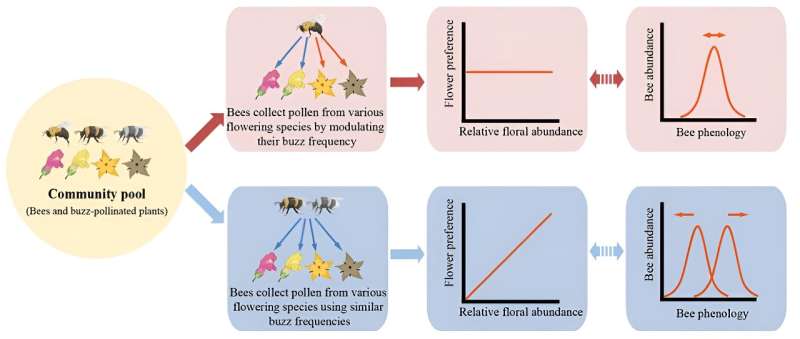This article has been reviewed according to Science X's editorial process and policies. Editors have highlighted the following attributes while ensuring the content's credibility:
fact-checked
trusted source
proofread
Interaction patterns between bumblebees and floral resources revealed during buzz pollination

Many plants conceal their pollen, requiring pollinators to use specialized methods, such as acoustic resonance pollen ejection, to achieve pollination. Pollinators with such capabilities are mainly bees (buzz pollination), with the bumblebee being the most representative.
In the process of buzz pollination and nectar exchange pollination, the interaction patterns and mechanisms between pollinators and floral traits differ significantly. In buzz pollination, the interaction patterns between pollinators and floral resources remain poorly understood.
The upper corolla of some Pedicularis species forms a specialized and innovative trait (i.e., a twisted beak-like structure) that envelops the anther, forcing pollinators such as bumblebees to release pollen through a "buzzing" method.
Focusing on five beaked Pedicularis species within the community that do not produce nectar and their three primary pollinating bumblebees, researchers from the Wuhan Botanical Garden of the Chinese Academy of Sciences conducted a five-year field experiment to investigate in depth the factors that influence bumblebee flower-visiting preferences.
The study was published in Entomologia Generalis titled "Bumblebees' flower preferences are associated with floral abundance and buzz frequency when buzz-pollinating co-flowering plants."
The research shows that when bumblebees use the same buzzing frequency to access different plants to obtain pollen, their flower-visiting preferences depend primarily on the abundance of floral resources and do not have a specific species preference.
When bumblebees use different buzzing frequencies to visit flowers of different plants, their flower-visiting preferences maintain a specific species preference, primarily for plants with greater pollen rewards.
This study elucidates the interdependent patterns of pollinator-flowering plant interactions based on acoustic traits, enriching the scientific understanding of the diversity of plant breeding strategies.
More information: Wen Huang et al, Bumblebees' flower preferences are associated with floral abundance and buzz frequency when buzz-pollinating co-flowering plants, Entomologia Generalis (2024). DOI: 10.1127/entomologia/2023/2096
Provided by Chinese Academy of Sciences




















